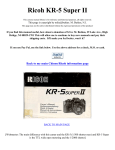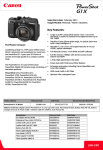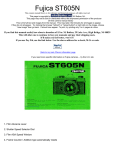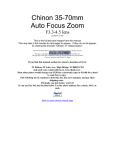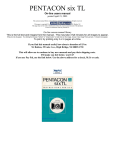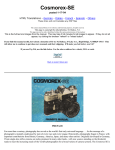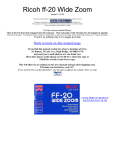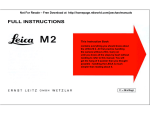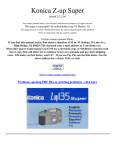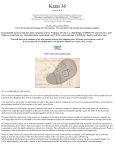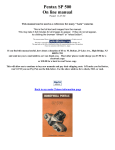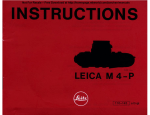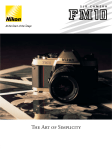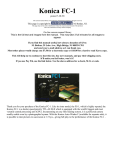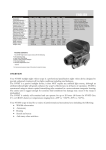Download to continue to pdf file made from this manual
Transcript
Chinon CM-5 Camera Manual For reference use on many Chinon manual focus and metering cameras using the 3 LED metering system This is the full text and images from the manual. This may take 3 full minutes for all images to appear. If they do not all appear. Try clicking the browser "refresh" or "reload button". This camera manual library is for reference and historical purposes, all rights reserved. This page is copyright by , M. Butkus, N.J. This page may not be sold or distributed without the expressed permission of the producer I have no connection with Chinon Co., Japan If you find this manual useful, how about a donation of $3 to: M. Butkus, 29 Lake Ave., High Bridge, NJ 08829-1071 and send me your e-mail address so I can thank you. Most other places would charge you $7.50 for a electronic copy or $18.00 for a hard to read Xerox copy. This will allow me to continue to buy new manuals and pay their shipping costs. It'll make you feel better, won't it? If you use Pay Pal, use the link below. Use the above address for a check, M.O. or cash. To main Chinon/Ricoh manual site TABLE OF CONTENTS NOMENCLATURE - 2 SPECIFICATIONS - 6 LENS MOUNTING - 10 1 INSTALLING THE BATTERIES - 12 BATTERY TESTING - 16 FILM LOADING - 18 USING THE MEMO HOLDER - 20 FRAME COUNTER - 22 ADVANCING THE FILM - 24 ASA/DIN SETTING - 24 SHUTTER SPEED SETTING - 24 APERTURE SETTING - 26 FOCUSING - 28 DETERMINING CORRECT EXPOSURE - 30 UNLOADING EXPOSED FILM - 36 USING THE ELECTRONIC FLASH - 38 DEPTH OF FIELD - 40 SELF-TIMER - 42 CHINON POWER WINDER (PW-545/610) - 44 AUTO FOCUS 50 MM MC F1.7 LENS - 46 AUTO FOCUS 35-70 MM F3.3-4.5 LENS - 47 INFO BACK IMPRINTING UNIT - 48 INFO BACK-2 IMPRINTING UNIT - 48 AUTO DATE (AD-510) - 49 INFRA-RED PHOTOGRAPHY - 50 OPTIONAL ACCESSORIES FOR CHINON CM-5 - 52 CARE OF THE CAMERA - 54 2 NOMENCLATURE 1. Shoulder strap eyelet 2. Frame Counter 3. Shutter release button/exposure meter switch 4. Film advance lever 5. Shutter speed dial 6. Film speed window (ASA/DIN) 7. Hot Shoe 4.butkus.org 8. Film rewind knob/back cover opener 9. Body grip setting holes 10. Self-timer lever 11. Lens lock release lever 12. Aperture ring 13. Depth of field scale 14. Focusing ring 3 15. Film chamber 16. Exposure indicator LED's/battery check lamp 17. Viewfinder eyepiece 18. Sprocket teeth 19. Take-up spool 20. Film pressure plate 21. Film chamber cover 22. Power winder coupler 23. Rewind knob 24. Film guide rail 25. Film rail 26. Tripod socket 27. Shutter 28. Battery compartment cover 29. Power winder electronic contacts SPECIFICATIONS Type: 35 mm SLR compact camera with LED type light measuring system. Picture Format: 24 x 36 mm. Lens Mount: Chinon Universal Bayonet Mount. (Pentax K-mount) Mirror: Large, Quick return, shockless system. Shutter: Seiko MFC metal focal plane shutter. Shutter Speeds: 1 sec. - 1 /1000 sec., "B". Viewfinder: Fixed eye-level pentaprism, central split image with microprism collar and ground glass. 4 Viewfinder Magnification: 0.87 x (@ 50 mm, infinity). Viewfinder Visibility: 92%. Exposure Meter: TTL, Center weighted full aperture system employing one silicon blue photo cell, 3 steps exposure indicator with 3 LEDs. Exposure Range: EV + 2 (F/1.9,1 sec.) to EV + 18 (F/16, 1/1000 sec.)—ASA100 F/1.9 lens. Meter ON/OFF Switch: Meter switch is activated when shutter release button is pressed, meter remains on for several seconds after finger is lifted off release button. ASA Range: 25 - 1600 (DIN 15 - 33) with safety lock. Film Advance: Single stroke in an arc of 130° with 25° stand off. Aim Counter: Automatically indicates number of exposures and resets to "S" when camera back is opened. Film Rewind: Folding crank type. Accessory Shoe: Hot Shoe type with X sync. Self-Timer: Built-in. Synchronization: Strobe Sync. at 1/60 sec. Power Winder Contacts: Power winder electronic contacts are built in for a single frame picture advance. Power Source: Two 1.5 V Alkaline batteries (LR44 A76) or two 1.5 V silver oxide batteries (SR44, S76, G-13). 4www.butkus.org Battery Test: Built-in with LED indicator. Accessories: Multi-coated lenses, Auto electronic flashes, carrying case, and many more. Body Dimensions: 135.5 (W) x 86.0 (H) x 50.5 (D) mm. (5.33" x 3.78~ x 1.99~) Body Weight: 455 grams (16.05 oz). 5 LENS MOUNTING Your CHINON CM-5 is equipped with a CHINON bayonet mount which accepts all interchangeable lenses with the bayonet mount. To attach the lens, match the red dot on the camera body with the red dot on the lens (Fig. 1). Then insert the lens into the camera body and turn it clockwise until the lens locks with a click. To remove the lens from the camera body, depress and hold the lens lock release lever on the camera body, turn the lens counterclockwise as far as it will go, and lift it up from the Body (Fig. 2). 4.butkus.org INSTALLING THE BATTERIES 6 1. By using a coin, unlock the battery chamber cover by turning it counterclockwise (Fig. 3). 2. Place two 1.5 V Alkaline batteries (LR44, A76) or two 1.5 V silver oxide batteries (SR44, S76, G13) with the minus (-) side touching the battery cap (Fig. 4) 3. Replace the battery chamber cover by turning fully clockwise (Fig. 5). NOTE: Clean the batteries with a dry cloth or paper before inserting and thereafter at regular intervals. Make sure that the batteries are inserted correctly, i.e., check polarity. The shutter will operate only when batteries are correctly installed and not exhausted. Body Grip (Spare battery storage compartment) You can attach an optional body grip to your CM-5 camera (Fig. 6). To do so, attach the body grip to corresponding body grip setting holes on the camera and tighten the screw on the bottom of the body grip by turning it clockwise. The body grip has a convenient battery storage compartment in which you may store one set (2 pcs.) of spare batteries. To remove the batteries from the compartment, pull on the battery holding lever (Fig. 7). BATTERY TESTING Test the batteries when; — a new battery is installed — the camera has not been used for a long period of time — the camera is being used continuously for many hours. To test the batteries, press the shutter release button slightly. If the batteries are in good condition, one of three LED's located at the left side of the viewfinder frame will illuminate (Fig. 8). If a LED fails to illuminate, the batteries are too weak and need to be replaced, they are incorrectly inserted, or the speed selector is set to "B" position. 7 4.butkus.org FILM LOADING Your Chinon CM-5 camera can be used with any kind of 35 mm film. 1. Pull up the film rewind knob until the camera back pops open (Fig.9). 2. Then, insert a film cartridge into the film chamber with the protruding end facing the bottom of the camera (Fig. 10). 3. Push in the film rewind knob and slightly turn the knob in either direction until it catches the film cartridge spool. 4. Insert the trimmed end of the film into a slot of the multi-slotted take-up spool. 5. Turn the shutter speed selector to any setting and advance the film while holding the film lightly down on to the transport. 6. Release the shutter if necessary and advance the film until the sprockets engage with the upper and lower perforations of the film (Fig. 11). 7. Close the camera back firmly until it locks with a click. 8. Turn the film rewind knob gently until the film slack is taken up and the rewind knob stops turning freely. 9. Do not force or further rewind the film. 8 10. Advance the film and release the shutter three times (Fig. 12). The rewind knob should rotate counterclockwise when the film is advanced and the "1" marking should appear in the frame counter window (Fig. 13). USING THE MEMO HOLDER The Chinon CM-5 compact SLR camera has a built-in memo holder feature. To utilize the memo holder feature, simply cut off the top of the film box and insert it into the memo holder located on the back cover of your camera. This will enable you to quickly and easily identify the type of film and ASA speed used in the camera. Your calling card can also be inserted in the memo holder (Fig. 1 4). FRAME COUNTER Your Chinon CM-5 is equipped with a frame counter which displays the number of exposures made and resets automatically upon opening the camera back. When the camera back is opened the counter shows "S" indicating the start of the picture taking process. When a film is loaded according to the procedure previously described, the counter displays "1 " indicating that the camera is ready for the first exposure Every time the film advance lever is turned the counter will proceed one stop forward. The number 24 and 36 are colored in orange to warn the end of commonly available films (Fig. 1 5). ADVANCING THE FILM Make sure the film has been loaded properly. Operate the film advance lever through a full stroke. When the film end is reached the film advance lever may stop before the lever is fully turned. Do not force the lever. Stop winding at once and rewind the film. Refer to "Unloading Exposed Film". 9 ASA/DIN SETTING The ASA/DIN speed of the film is specified on the box or in the instruction sheet packed with the film. Set the ASA/DIN speed by lining UP and rotating the shutter speed dial to be appeared in the film speed window. Be sure to check the ASA number whenever you put new film into the camera (Fig. 16). SHUTTER SPEED SETTING Rotate the shutter speed dial to the left or right to select a suitable shutter speed from the band of "B", 1 to 1/1000 sec. (Fig. 17). APERTURE SETTING The aperture is set in the usual way by rotating the lens diaphragm ring until the desired F stop is set against the green index mark on the lens barrel. For further explanation see "Determining Correct Exposure" (Fig. 18 & 19). F stop Selection: The following may be used as a guide to determine the lens F stop when you are using the camera; 4.butkus.org · Sunny day outside: F/8 - F/16 · Cloudy day outside: F/4 - F/5.6 · Inside (without flash): F/1.9—F/2.8 10 FOCUSING Your Chinon CM-5 has three built-in focusing aids. The center of the viewfinder is the split image with microprism collar which is surrounded by ground glass. When the camera is in focus, the image of these focusing aids become sharpest. While observing the subject through the viewfinder, turn the lens focus ring until the upper and lower splitimage match up to form a uniform image (Fig. 20). This split image focusing is particularly helpful when the subject is dominated by vertical lines. The microprism is also helpful. When it is out of focus, the image on the microprism will be composed of collection of asterisks (Fig. 21). These sparkling asterisks will disappear when the focus is properly set. You can double check the focus setting by the image on the ground glass. You can also focus indirectly. Actually measure or estimate the distance to the subject and set the lens focus ring to the appropriate setting (Fig. 22). DETERMINING CORRECT EXPOSURE Your Chinon CM-5 camera has a Through The Lens (TTL) exposure metering system. Also called an open aperture measuring system. determine the correct exposure, To operate the film advance lever, observing the subject through the viewfinder in the center of microprism area. Depress the shutter release button until the exposure indicator lamp (LED) located on the left side of the viewfinder frame illuminates (Fig. 23). Should the green lamp (LED) not illuminate, you must turn either the shutter speed dial or the lens aperture ring until the green lamp illuminates. By doing so, you will be assured of a correct exposure. 11 *The Exposure Indicator: Your Chinon CM-5 camera has three exposure indicator lamps (LED) located at the left side of the viewfinder frame. These three lamps control the condition of exposure of the camera. The conditions of exposure can be confirmed in the following three ways; RED GREEN RED A: Over Exposure B: Correct Exposure C: Under Exposure When rotating the shutter speed dial or the lens aperture ring, you must operate them slowly since the exposure indicator lamps are very sensitive. Generally you should select a shutter speed first then operate the lens aperture ring until the proper exposure is obtained. A tripod should be used for shutters speed longer than 1/30 sec. NOTE: The exposure indicator lamp does not illuminate when the shutter speed dial is set at "B" position. The meter switch is activated when the shutter release button is pressed and the meter remains on for several seconds after your finger is lifted off the release button. UNLOADING EXPOSED FILM When the film in the camera is fully exposed, the film advance lever will stop. Do not attempt to force the lever any further. Rewind the film and replace with a new film. Push in the rewind button at the bottom of the camera (Fig. 24). Unfold the rewind crank of the rewind knob and turn the rewind crank clockwise (Fig. 25). You will feel friction as the film is rewound. Suddenly, when the film is rewound completely, the friction decrease and the rewind crank will turn with ease. Pull up the rewind knob to open the camera back (Fig. 26). When the camera back is opened, the frame counter will automatically reset to the "S" position. The rewind button on the bottom of the camera will pop out upon the next advancement of the film advance lever. Your exposed film should be processed without delay. 4.butkus.org 12 USING THE ELECTRONIC FLASH It is advisable to use a flash when the exposure indicators detect that the light level is too low, such as indoors, at night time, or in daylight when the subject is too dark to provide adequate exposure. Electronic flash units as well as conventional flash units using flash bulbs may be utilized. Your CM-5 has a hot shoe (Accessory shoe with built-in flash contact) for "X" synchronization (Fig. 27). Electronic flash units having a foot with built-in contact may be used without connection cord. As the hot shoe has "X" type synchronization it can be used with electronic flash at 1/60 sec. or at slower shutter speeds (Fig. 28.) The lens aperture is determined by the calculation table indicated on the flash unit. Specially designed and developed automatic flash units are available for your Chinon CM-5 as optional accessories. This highly advanced electronic flash system permits carefree flash photography for you. DEPTH OF FIELD Depth of field designates the nearest and furthest limits of the area that will be sharp in the picture in front of and beyond the subject. Depth of field is controlled by the f/stop. The larger the lens opening, the shallower is the depth of field. The smaller the lens opening, the grease, the depth of field becomes (Fig. 29 & 30). 13 Depth of Field Scale: The depth of field scale indicates (after focusing) the approximate area that will be sharp in the picture. Locate on the depth of field scale the corresponding pair of f/stop figures. The distance between these two f/ stop figures on the focusing ring will be the area of sharpness in your picture (Fig. 31). SELF-TIMER The self-timer when set, trips the shutter mechanism after a delay of 7 - 12 seconds. This feature is useful should the photographer wish to be included in the picture, and is also useful for taking pictures at slow shutter speeds when a cable release is not available. When using the self-timer, the camera must be mounted on a tripod, or a solid support of some kind. To operate, move the self-timer lever counterclockwise as far as it will go. Advance the film transport lever. Upon pressing upward on the self-timer lever with your finger, the self-timer mechanism will start to operate (Fig. 32). NOTE: Do not depress the shutter release button, since the self-timer mechanism will not operate and the shutter will be released instantly. NOTE: Do not advance the film advance lever while the self-timer is in operation, otherwise damage to the camera's internal mechanism could occur. 4.butkus.org 14 POWER WINDER (PW-545/610) When using CM-5 in conjunction with power winders 545 and 610, only the single frame advance will function with both units. Furthermore, the power winders will only advance the film when the camera's shutter release is depressed and released. The shutter release button on the power winder's built-in grip is nonfunctional when used with CM-5. (Fig. 33). NOTE: 1. Caution should be used not to set the C/S dial in the "C" position. 2. Care should be taken to avoid depressing the shutter release on the power winder grip when depressing the camera's shutter release as the power winder will not advance the film when the button is kept depressed. 3. Do not attempt to use the remote control socket when the power winder is used in conjunction with CM-5. 4. Do not use the self-timer when the Power winder is in use. Auto Focus 50MM MC F/1.7 Lens Focuses even in total darkness. Stepless operation even from 1M to infinity. Aperture range from F 1.7 to F 22. Audible signal beeps when subject is in focus. [Mike: very impossible to find, works by pressing side button] Chinon 35-70mm Auto Focus F 3.3 - F 4.4 Zoom. Operation same as 50mm AF lens. Built in power on/off switch. When the subject is too close to AF (less then 1 meter) the camera will give a continuous audible signal, stating manual focusing is required. [Mike: even more impossible to find. Pins on the lens couple to the CG-5 and CE-5 camera body] 15 Chinon Infoback Imprinting Unit DB-010: Accessory data back features electronic input of up to 30 characters (alpha or numeric) of information onto your negative or slide, via a compact 36 button digital control panel. Built in memory features will continuously imprint the same message or can change the information as you like. Chinon Info Back-2 Digital Data-Imprinting Unit DP-520: Deluxe accessory data back. Same features as Info Back (DB-010) plus LCD readout via built-in monitor window. 16 Chinon Auto Date Quartz Digital Data Imprinting Unit (AD-S10) Accessories date back featuring electronic imprint of year, month, day and hour directly on your negative or slide. Date automatically resets until year 2019. (Mike: no Y2K problem!) Chinon Accessories INFRA-RED PHOTOGRAPHY Your CM-5 camera accepts infrared film. To use infra-red film an extra focusing adjustment must be made. After focusing note the figure that is adjacent to red diamond on the distance scale (Fig. 34), then move that figure over to the infra-red mark engraved on the lens. This adjustment is only required for black and white infra-red film. When using color infra-red film, focus in the normal way. NOTE: Read the instructions carefully packed with the infra-red film for further information. 17 CHINON OPTIONAL ACCESSORIES Standard Lenses 45 mm f/2.8, 50 mm f/1.9 50 mm f/1.7 multicoated 50 mm V1.7 AF 50 mm f/1.4 multicoated Wide-Angle Lenses 28 mm f/2.8 multicoated 35 mm f/2.8 multicoated Telephoto Lenses 135 mm f/2.8 multicoated 200 mm f/3.5 multicoated 300 mm f/5.6 multicoated 500 mm f/8 reflex Ape 35-70 mm f/3.3-4.5 AF Zoom 35-100 mm f/3.5-4.3 MC Macro 80-200 mm f/4.5 MC Macro 70-210 mm f/3.8 MC Macro 100-300 mm F5.6 MC Macro Accessories PW-545 & PW-610 Info Back DB-010 Info Back-2 DP-520 Auto Date AD-510 CHINON Auto S-180 flash CHINON Auto S-240 flash 18 CHINON Auto S-280 flash CHINON Auto S-360 Flash Synchro-eye for flash (Slave Unit) Wireless Remote Control set for Power Winder Deluxe Carrying case Neck Strap Filter (UV, Y2, ND4X, PL) Rubber Eyepiece Eyepiece Adaptor (-3, +1, +3) Angle Finder 2 clips lens cap 1.5 V Alkaline Batteries (3 pcs in one sat) Rubber Lens hood Auto Extension Ring Bellows Mini Copy Stand Table Tripod Cable Release (13 inch) (any brand will do) Remote Control Unit Spare ring for Mini Copy Stand Lens Mount Cap Body Cap CARE OF THE CAMERA Your Chinon CM-5 camera is a precision instrument. Used with care, it will provide years of service. Protect your camera from dirt, rain, dampness, and excessive heat. Avoid touching the lens. To clean the lens, wipe it gently with a soft lintless cloth or lens tissue. Do not use eyeglass tissue as they might damage the lens coating. 19




















